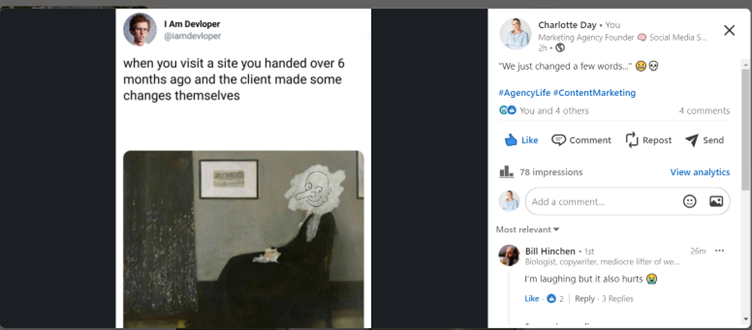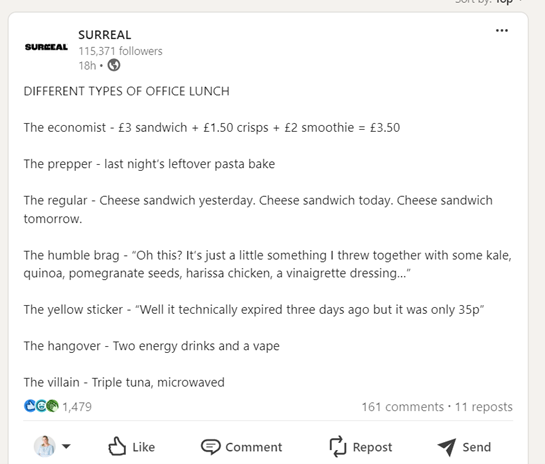I’m often asked by clients about humour on LinkedIn. What works and what doesn’t? Should your brand be using humour on the platform? Let’s do a deep dive on LinkedIn humour.
When Did LinkedIn Start Being Funny?
LinkedIn is known as the world’s largest professional networking platform. 97% of Fortune 500 CEOs are on LinkedIn so it’s the best place to connect with decision makers and business influencers. And with that comes a rather tightly buttoned formality that isn’t necessarily human or authentic. Traditionally, posts focused on professionalism, industry insights, or leadership advice. They were written in a serious tone, and some could be quite cringeworthy at times. Everyone was honoured to receive awards, delighted to have been recognised and thrilled to be attending events. And let’s be honest, I was guilty of a few of those too. But times are changing and a growing trend is breaking through the corporate facade and that’s humour. I noticed the change in the past two years and really embraced it as being a far more authentic representation of my professional character.
Why Did LinkedIn Become more Humourous?
LinkedIn was launched in 2003 and over the years we’ve seen it adapt to new technologies, trends and employment needs like hybrid and work from home. There are a few reasons why I think it became more humourous lately. Firstly, working from home during 2020-2022 accelerated the blending of professional and personal lives. We had our cats in the background of Zoom calls (I still do), worked in pyjama bottoms and embraced a better work life balance. Secondly, infobesity and content fatigue are real things. We are exposed to up to 10,000 ads per day. Plus blogs, posts, videos, and images. In short, we’re tired of corporate jargon, business insights, and leadership ramblings. Humour emerged as a way to break through this monotony and connect with people in a more authentic way. Lastly, workplace culture has changed. Dress codes are more casual, hierarchies are softer, and we aim for a more transparent “people first” culture. This cultural shift has trickled down into the way people use LinkedIn.
What Type Of Humour Can You Find On Linkedin?
Like all social media networks, LinkedIn can be an echo chamber. If you post and follow humourous content, you’re likely encounter and connect with similar personalities. LinkedIn humour includes situational memes, funny work stories, client stories and TikTok’s shared into the LinkedIn feed. LinkedIn users understand the importance of professionalism, but also want to showcase authenticity and uniqueness. A well-timed joke, trending meme, or humorous reflection on your industry can positively shape the way people perceive you and your brand.

Should Brands Be Humourous On LinkedIn?
Not always. We always create a tone of voice strategy with new clients. This, in addition to a tailored social media strategy ensures that we understand the brand’s ethos, target audience and brand characteristics. For example, a pharmaceutical brand is unlikely to want to embrace humour on LinkedIn. They will want to convey safety, wellbeing and positive shareholder focused news. Whilst conversely, modern food brands like Surreal can be a lot more playful with relatable workplace humour.

Brands might also have a very different strategy for humour across different social media channels. Ryanair and Greggs are hilariously funny and snarky on Twitter (X), TikTok and Facebook. But on LinkedIn their focus is on corporate growth, events, awards and milestones. Their audience is likely not the same, becoming more B2B than B2C, and therefore their content adapts accordingly.
Does Humour Help Companies and Users To Grow their Audience?
As we said before, humour is not for every brand, and that’s completely fine. But it does work effectively when used the right way. It works by being memorable, relatable and different. A study found that posts on LinkedIn with a humorous or relatable tone often see up to 6x higher engagement compared to more formal posts. And, according to Forbes, professionals who use humour effectively in their LinkedIn posts and profiles are 27% more likely to be remembered, whether that’s by employers or clients. And then there’s the emotional resonance. LinkedIn Business reported that posts using humour see 10-20% higher emotional engagement. This increased emotional connection helps users build rapport more quickly making it easier to reach out to a potential client, new connection, or future employer.
LinkedIn’s content feed is typically filled with articles, industry reports, and unfortunately some rather cringe motivational quotes. A funny post on a common workplace issue grabs attention and garners engagement. And as a professional network, there’s a lot of job searching and hiring happening. Brands and candidates who use authentic humour in their posts might just be more eye catching and appealing. If people associate your posts with positive emotions, they’re more likely to remember you, follow your updates, and engage with your content regularly. That doesn’t mean that every post should be humour based. But it does mean a shift towards a more natural and authentic way of communicating on the platform. And ultimately, I want to have authentic relationships with clients, colleagues, partners, and media outlets. Professional yes. But also real.
Ready for a rethink on your content marketing strategy? Get in contact with me for strategy, social media management and content writing.